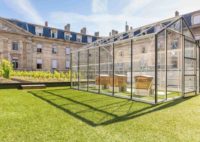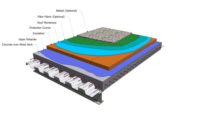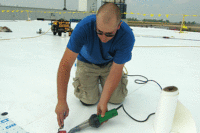Trends and Considerations for Design of Sustainable Roofing Systems
Current trends applied to sustainable design and construction of roofing systems emphasize widespread practices that cover the design and construction process of sustainable building in general.

Current trends applied to sustainable design and construction of roofing systems emphasize widespread practices that cover the design and construction process of sustainable building in general. These principles, such as those contained in the Green Building Council’s LEED rating system, emphasize factors such as improving thermal performance through enhanced insulation and roof surface reflectivity, increased recycled material content, and use of rapidly renewable resources. These features are important to sustainability but do not fully recognize or emphasize some important aspects of roofing system performance that differentiate roofing from other building systems.
Concern has arisen in the roofing industry that current trends do not adequately consider durability, life cycle costs, and effects of premature failure (McKay 2007, Hoff 2008). The roofing designer should recognize that the roof’s primary purpose is to protect the building from outside elements, and to do so for a long time (longevity) and with minimal unplanned intervention (reliability).
Furthermore, the consequence of catastrophic or widespread roof failure can require extensive reconstruction of finishes and replacement of contents inside the building. In contrast, failure of other building systems may only require replacement of the failed system or various components.
In 2001, Publication 271 by the CIB W083/RILEM 166-MRS Joint Committee on Roofing Materials and Systems defined 21 key aspects of sustainability related to roofing (the “Tenets of Sustainable Roofing”), divided into the following three categories:
1. Minimize burden on the environment
2. Conserve energy
3. Extend roof lifespan
CIB Publication 271 also stresses that the above-listed categories are not separable. All must be considered in the design of a sustainable roofing system. Current trends address primarily the first two of these categories.

Sustainability (S) = (L*B)/I (Olson, 2011)
- L (Service Life) is the service life of the roof (years). All else equal, lengthening of service life improves sustainability.
- I (Impact) is the cradle-to-grave (life cycle) environmental impact, which may be lowered by use of recycled content, use of renewable resources, or “environmentally friendly” material. All else equal, lowering environmental impact improves sustainability.
- B (Benefits) represents the sum of in-service environmental benefits, which may include energy conservation realized by optimized insulation or surface reflectivity. Increasing B improves sustainability for the service life of the roof.
Inputs for the equation are not necessarily quantifiable, so it should not be construed as a mathematical relationship. The equation’s purpose is to illustrate sustainability relationships in a qualitative manner. This equation also illustrates that, if longevity and durability are not a priority, the level of sustainability can be low even if sustainable benefits are high and the environmental impact is low.
Construction of a sustainable roof begins with the planning and design of the roof. Steps include planning for serviceability and durability (Hoff and Kane, 2010), identifying candidate systems that fulfill durability expectations and resist environmental influences, and narrowing the candidates down to those systems having the least environmental life cycle impact. A description of this process (Olson, 2011) can be summarized as follows:
Identify Roofing System Environmental and Service Demands: These include code-specified requirements such as climate zone, wind uplift pressure, and snow load. But of equal importance is identification of functional demands not driven by code. These can include rooftop use for mechanical equipment, levels of humidification and pressurization inside the building, solar load, prevailing pollutants, and demand to use the roof space for vegetation or open space.
Establish System Requirements for Durability and Performance: The goal of this step is to maximize the value L in the sustainability equation above. The roofing system must be detailed and specified with physical and performance properties to meet the environmental and service demands. For example, if heavy foot traffic is expected, walkways are likely needed to protect the roof. If high indoor humidification is to be maintained, a robust roof air and vapor barrier system with a high level of detailing to ensure continuity with surrounding construction is needed to protect the roof from internally generated moisture. Roofs that fail to meet the service and environmental demands due to improper definition of durability and performance requirements are likely to fail. Disposal and replacement of the failed roofing system and other damaged building components have obvious and severe environmental and economic consequence.
Identify Candidate Systems: The defined durability and performance requirements yield a basis for identifying candidate systems suitable for the project. For each candidate system, the designer should identify the service life expectations (based in large part on track record of proven performance); maintenance needs; and environmental impact considerations such as effect on building energy use, use of recycled content, or ability to reuse or recycle roofing materials at the end of the roof’s service life. This step defines the environmental impact (I) and sustainable benefits (B) in the sustainability equation above. Obtaining a full set of parameters for the candidate systems’ environmental impact is limited, since, at present, there is no consensus standard for performing an environmental life cycle assessment of roofing systems.
Select Roofing System Based on Optimum Sustainability: The goal of this step is to optimize S in the sustainability equation. Based on the expected service life, environmental impacts, and other factors determined for the candidate systems, use the sustainability equation above to identify the roofing system with the greatest sustainability. As the sustainability equation suggests, the roof with the longest service life is not necessarily the optimum sustainable option. Roof systems having greater flexibility in component reuse or with lower environmental life cycle impact but with shorter service lives can sometimes prove more sustainable.
Roofs are expensive and complex systems that must be cared for and maintained. Care and maintenance instructions and training should be provided to the purchaser. A purchaser without the means to properly care for the roof should be advised to retain an outside entity to inspect and maintain the roof system. A well-designed and properly installed roofing system can fail if abused or neglected.
Hutchinson, Tom, “Achieving Sustainability of a Roofing System,” RCI Interface, Dec. 2007. Hoff, J. L., and E. Kane, “The Durability Planning Matrix: A Useful Tool for Achieving Sustainable Building Envelopes.” RCI 25th International Convention and Trade Show. Orlando, FL. 25 – 30 Mar. 2010. Roof Consultants Institute.
Hoff, J. L., “Sustainable Buildings: Addressing Long-Term Building Envelope Durability.” RCI 23rd International Convention and Trade Show. Phoenix, AZ. 28 Feb. – 4 Mar. 2008. Roof Consultants Institute. Olson, E. K., “Sustainable Low-Slope Roofing – A Design Process,” 2011 Building Envelope Sustainability Symposium. Pomona, CA. 29 – 30 Apr. 2011.

The New Orleans Superdome exemplifies the negative environmental impact resulting from catastrophic roofing failure.
Current trends applied to sustainable design and construction of roofing systems emphasize widespread practices that cover the design and construction process of sustainable building in general. These principles, such as those contained in the Green Building Council’s LEED rating system, emphasize factors such as improving thermal performance through enhanced insulation and roof surface reflectivity, increased recycled material content, and use of rapidly renewable resources. These features are important to sustainability but do not fully recognize or emphasize some important aspects of roofing system performance that differentiate roofing from other building systems.
Concern has arisen in the roofing industry that current trends do not adequately consider durability, life cycle costs, and effects of premature failure (McKay 2007, Hoff 2008). The roofing designer should recognize that the roof’s primary purpose is to protect the building from outside elements, and to do so for a long time (longevity) and with minimal unplanned intervention (reliability).
Furthermore, the consequence of catastrophic or widespread roof failure can require extensive reconstruction of finishes and replacement of contents inside the building. In contrast, failure of other building systems may only require replacement of the failed system or various components.
In 2001, Publication 271 by the CIB W083/RILEM 166-MRS Joint Committee on Roofing Materials and Systems defined 21 key aspects of sustainability related to roofing (the “Tenets of Sustainable Roofing”), divided into the following three categories:
1. Minimize burden on the environment
2. Conserve energy
3. Extend roof lifespan
CIB Publication 271 also stresses that the above-listed categories are not separable. All must be considered in the design of a sustainable roofing system. Current trends address primarily the first two of these categories.

The roof system must coexist with its surroundings. Placing a gravel-surfaced roof in proximity to sloped glazing resulted in broken glass and required replacement of the gravel-surfaced roof covering.
Relationships between Longevity and Sustainability
A relationship clearly exists among the overall sustainability of a roofing system, its environmental impact, and its longevity (service life). The author proposed the following sustainability equation to help illustrate this relationship:Sustainability (S) = (L*B)/I (Olson, 2011)
- L (Service Life) is the service life of the roof (years). All else equal, lengthening of service life improves sustainability.
- I (Impact) is the cradle-to-grave (life cycle) environmental impact, which may be lowered by use of recycled content, use of renewable resources, or “environmentally friendly” material. All else equal, lowering environmental impact improves sustainability.
- B (Benefits) represents the sum of in-service environmental benefits, which may include energy conservation realized by optimized insulation or surface reflectivity. Increasing B improves sustainability for the service life of the roof.
Inputs for the equation are not necessarily quantifiable, so it should not be construed as a mathematical relationship. The equation’s purpose is to illustrate sustainability relationships in a qualitative manner. This equation also illustrates that, if longevity and durability are not a priority, the level of sustainability can be low even if sustainable benefits are high and the environmental impact is low.
Designing For Longevity and Sustainability
A sustainable roof must be durable – designed and constructed to reliably resist in-service factors it will be exposed to such as weathering, wind, water, foot traffic, and other rooftop activities, and to do so with minimal intervention except for planned maintenance. These demands are application and site specific, so there is not a “one size fits all” roof system. A current industry goal for long-term performance for a roofing system is 30 years or greater (Hutchinson, 2007). Expect this goal to increase.Construction of a sustainable roof begins with the planning and design of the roof. Steps include planning for serviceability and durability (Hoff and Kane, 2010), identifying candidate systems that fulfill durability expectations and resist environmental influences, and narrowing the candidates down to those systems having the least environmental life cycle impact. A description of this process (Olson, 2011) can be summarized as follows:
Identify Roofing System Environmental and Service Demands: These include code-specified requirements such as climate zone, wind uplift pressure, and snow load. But of equal importance is identification of functional demands not driven by code. These can include rooftop use for mechanical equipment, levels of humidification and pressurization inside the building, solar load, prevailing pollutants, and demand to use the roof space for vegetation or open space.
Establish System Requirements for Durability and Performance: The goal of this step is to maximize the value L in the sustainability equation above. The roofing system must be detailed and specified with physical and performance properties to meet the environmental and service demands. For example, if heavy foot traffic is expected, walkways are likely needed to protect the roof. If high indoor humidification is to be maintained, a robust roof air and vapor barrier system with a high level of detailing to ensure continuity with surrounding construction is needed to protect the roof from internally generated moisture. Roofs that fail to meet the service and environmental demands due to improper definition of durability and performance requirements are likely to fail. Disposal and replacement of the failed roofing system and other damaged building components have obvious and severe environmental and economic consequence.
Identify Candidate Systems: The defined durability and performance requirements yield a basis for identifying candidate systems suitable for the project. For each candidate system, the designer should identify the service life expectations (based in large part on track record of proven performance); maintenance needs; and environmental impact considerations such as effect on building energy use, use of recycled content, or ability to reuse or recycle roofing materials at the end of the roof’s service life. This step defines the environmental impact (I) and sustainable benefits (B) in the sustainability equation above. Obtaining a full set of parameters for the candidate systems’ environmental impact is limited, since, at present, there is no consensus standard for performing an environmental life cycle assessment of roofing systems.
Select Roofing System Based on Optimum Sustainability: The goal of this step is to optimize S in the sustainability equation. Based on the expected service life, environmental impacts, and other factors determined for the candidate systems, use the sustainability equation above to identify the roofing system with the greatest sustainability. As the sustainability equation suggests, the roof with the longest service life is not necessarily the optimum sustainable option. Roof systems having greater flexibility in component reuse or with lower environmental life cycle impact but with shorter service lives can sometimes prove more sustainable.
Other Considerations after Design Completion
A completed design for a sustainable roofing system is just the first step in the process. The best design can be negated by value engineering away critical components for marginal cost savings, substitution of time-proven materials with materials having no or little track record, poor construction, failure to protect the roof during construction, or failure to maintain the roof throughout its service life. A comprehensive roof commissioning process may help avert these pitfalls. The process should keep the roof designer involved throughout the construction process to weigh in on proposed changes to the system and warn of potential consequences to such changes. Construction should employ tradesmen qualified to install the systems, protect the roof from construction activity, and employ third-party inspection to identify nonconforming work.Roofs are expensive and complex systems that must be cared for and maintained. Care and maintenance instructions and training should be provided to the purchaser. A purchaser without the means to properly care for the roof should be advised to retain an outside entity to inspect and maintain the roof system. A well-designed and properly installed roofing system can fail if abused or neglected.
Moving Forward
There is presently no consensus within the roofing industry on how to achieve a sustainable roofing system. Committee D08 on Roofing and Waterproofing within ASTM International is currently developing standards applicable to sustainable roofing practice. These standards will address sustainable roofing issues such as design, durability, recycling, and environmental life cycle assessment of roofing systems.Conclusions
Current approaches to sustainability are broad in their scope, and using them does not necessarily yield a sustainable roof. Roofs are unique in that their primary purpose is to protect the entire building from the outdoor environment. Design of sustainable roofing should first focus on meeting the service and environmental conditions that the roofing system must endure. Other sustainable aspects, such as reduction in environmental impact, can only be considered after roofs meeting service and environmental demands have been identified. The sustainable roof is an optimum solution which considers not only environmental impacts, but durability and service life as well. The sustainable roofing process extends through construction and throughout the life cycle of the roof.References:
“Towards Sustainable Roofing,” Report of the CIB W083/RILEM 166-MRS Joint Committee on Roofing Materials and Systems, CIB Publication No. 271, July 2001.Hutchinson, Tom, “Achieving Sustainability of a Roofing System,” RCI Interface, Dec. 2007. Hoff, J. L., and E. Kane, “The Durability Planning Matrix: A Useful Tool for Achieving Sustainable Building Envelopes.” RCI 25th International Convention and Trade Show. Orlando, FL. 25 – 30 Mar. 2010. Roof Consultants Institute.
Hoff, J. L., “Sustainable Buildings: Addressing Long-Term Building Envelope Durability.” RCI 23rd International Convention and Trade Show. Phoenix, AZ. 28 Feb. – 4 Mar. 2008. Roof Consultants Institute. Olson, E. K., “Sustainable Low-Slope Roofing – A Design Process,” 2011 Building Envelope Sustainability Symposium. Pomona, CA. 29 – 30 Apr. 2011.
Looking for a reprint of this article?
From high-res PDFs to custom plaques, order your copy today!






